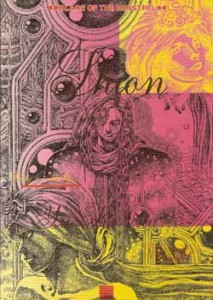
By Yu Kinutani, translated by Gerard Jones and Satoru Fujii (Viz Spectrum Editions)
ISBN: 0-929279-38-7 ISBN-13: 978-0-92927-938-1
Manga is so ubiquitous in our shops and libraries now it’s hard to remember when the works of Japanese graphic narrators were presented in all sorts of formats and genres to break through Western reluctance and snobbery. From the far ago late-1980s and the early days of the prolific Viz Communications comes this odd little fantasy package that impressed all the right people but seemingly has left little mark now.
Approximately the same dimensions as a US trade paperback, Viz Spectrum products displayed all the advantages of high quality black-and-white printing – crisp white paper, inserted tissue-paper fly-leaves, gold and silver metal inks and even clear plastic dust-jackets – as inducements for their product but eventually all these fell by the wayside as fans opted with their wallets for the basic digest-sized repro format that dominates today.
And the contents? Shion reprinted the earliest works of Yu Kinutani (who went on to produce Angel Arm, Layla & Rei and White Dragon) and features the first two appearances of a wandering minstrel and demon fighter.
The first story is ‘The Minstrel’ which finds a one-eyed musical vagabond strolling into a strange and Byzantine city reminiscent of Jack Vance’s Dying Earth tales where he finds witches and devils, drinks anti-gravity wine and rescues a damsel from a demon. This demon proves to be his own father who had taken his eye as part of a Faustian Pact. By killing the monster Shion restores his sire and his own eye.
At 16 pages The Minstrel was clearly intended as a one-off, but the character returned in a much longer epic (54 pages) entitled ‘Mirrors’ wherein the troubadour falls foul of depraved, decadent and incestuous sorcerers Toy and Doll; brother and sister in magic, imprisoned in a lost city by Nazuru god of swords for their crimes against humanity.
Freed after millennia the spiteful twins of evil once more play their foul, mutagenic games with human playthings until the Minstrel aided by the Sword of Nazuru finally ends them, only to continue his lonely aimless wandering…
Born in Ehime, Japan in 1962, Yu Kinutani cites Katsuhiro Otomo, Hayao Miyazaki (Princess Mononoke, Spirited Away, among a bunch of Studio Gibli classic films) and Jean Giraud AKA Moebius as his strongest influences, although a close look at the astoundingly striking, intricate artwork seems to indicate more than a little Jim Cawthorne and a lot of Philippe (Lone Sloan – Delirious & Yragael Urm) Druillet in the creative mix.
Whilst the storytelling is primal and concentrates on fantasy archetypes the unique blend of manga sensibility with European narrative design (like a somewhat harsher version of Naausica of the Valley of the Wind) makes this an inviting treat for older fantasy and comics fans, but don’t let the superficial similarities to Hideyuki Kikuchi’s Vampire Hunter D distract you; this is a dark fairy tale, not an all-action monster-mash.
© 1988 Yu Kinutani. English edition © 1990 Viz Communications, Inc. All Rights Reserved.
